Java - Java集合中的快速失败Fail Fast 机制
Posted 小小工匠
tags:
篇首语:本文由小常识网(cha138.com)小编为大家整理,主要介绍了Java - Java集合中的快速失败Fail Fast 机制相关的知识,希望对你有一定的参考价值。
文章目录
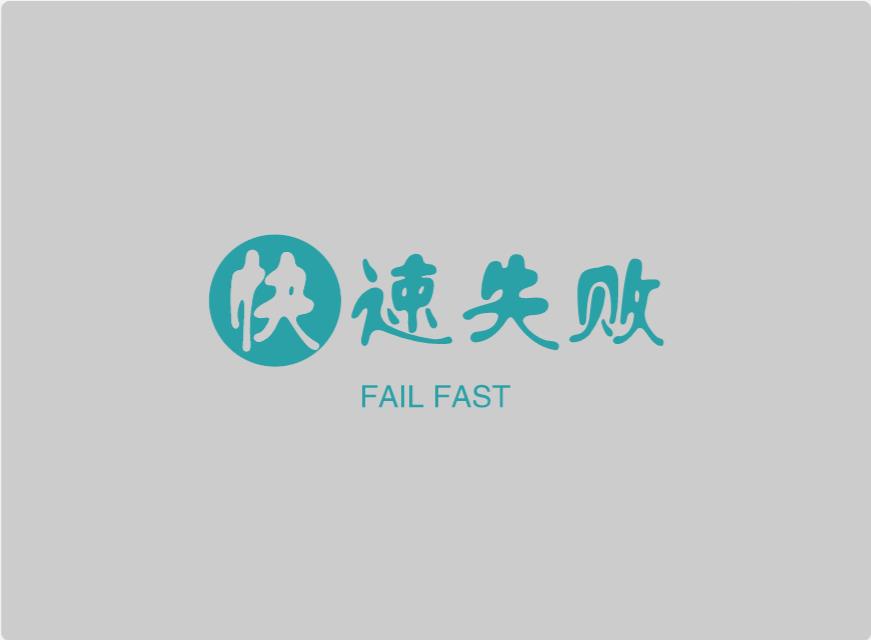
什么是 fail-fast
https://docs.oracle.com/javase/8/docs/api/java/util/ArrayList.html


fail-fast 机制是Java集合(Collection)中的一种错误机制。
在用迭代器遍历一个集合对象时,如果遍历过程中对集合对象的结构进行了修改(增加、删除),则会抛出Concurrent Modification Exception 【并发修改异常】。
举个例子:
在多线程环境下,线程1正在对集合进行遍历,此时线程2对集合进行修改 , 很容易抛出Concurrent Modification Exception 。
当然了,在单线程的情况下,遍历时对集合进行修改也会抛出Concurrent Modification Exception

此类的返回的迭代器iterator和 listIterator方法是快速失败的:如果列表在任何时间后,迭代器创建结构修饰,以任何方式除非通过迭代器自身 remove或 add方法,迭代器都将抛出 Concurrent Modification Exception。
因此,面对并发修改,迭代器快速而干净地失败,而不是冒着在未来不确定的时间出现任意、非确定性行为的风险。
源码解读
Itr
在遍历的时候对集合修改会发生fail-fast,遍历集合------> 迭代器

/**
* An optimized version of AbstractList.Itr
*/
private class Itr implements Iterator<E> {
int cursor; // index of next element to return
int lastRet = -1; // index of last element returned; -1 if no such
int expectedModCount = modCount;
Itr() {}
public boolean hasNext() {
return cursor != size;
}
@SuppressWarnings("unchecked")
public E next() {
checkForComodification();
int i = cursor;
if (i >= size)
throw new NoSuchElementException();
Object[] elementData = ArrayList.this.elementData;
if (i >= elementData.length)
throw new ConcurrentModificationException();
cursor = i + 1;
return (E) elementData[lastRet = i];
}
public void remove() {
if (lastRet < 0)
throw new IllegalStateException();
checkForComodification();
try {
ArrayList.this.remove(lastRet);
cursor = lastRet;
lastRet = -1;
expectedModCount = modCount;
} catch (IndexOutOfBoundsException ex) {
throw new ConcurrentModificationException();
}
}
@Override
@SuppressWarnings("unchecked")
public void forEachRemaining(Consumer<? super E> consumer) {
Objects.requireNonNull(consumer);
final int size = ArrayList.this.size;
int i = cursor;
if (i >= size) {
return;
}
final Object[] elementData = ArrayList.this.elementData;
if (i >= elementData.length) {
throw new ConcurrentModificationException();
}
while (i != size && modCount == expectedModCount) {
consumer.accept((E) elementData[i++]);
}
// update once at end of iteration to reduce heap write traffic
cursor = i;
lastRet = i - 1;
checkForComodification();
}
final void checkForComodification() {
if (modCount != expectedModCount)
throw new ConcurrentModificationException();
}
}
看到了吧, checkForComodification
final void checkForComodification() {
if (modCount != expectedModCount)
throw new ConcurrentModificationException();
}
在modCount != expectedModCount的时候抛出了ConcurrentModificationException,
而在next方法中上来就是调用checkForComodification,所以遍历集合才会可能抛出并发修改异常。
那接下来就研究 modCount 和 expectedModCount 什么时候会不相等就行了呗。
- 在创建一个迭代器后,
expectedModCount的初始值就是modCount了,
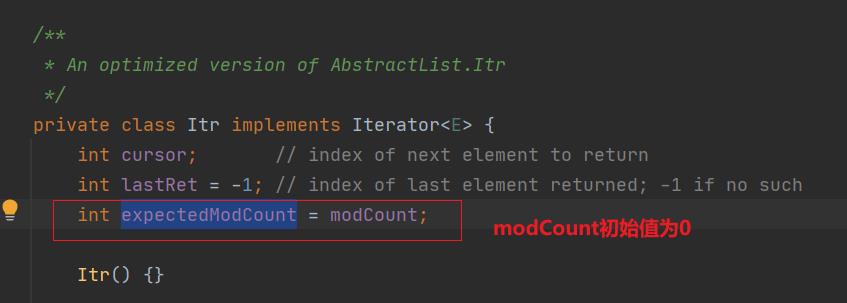
- 对集合修改会改变
modCount,
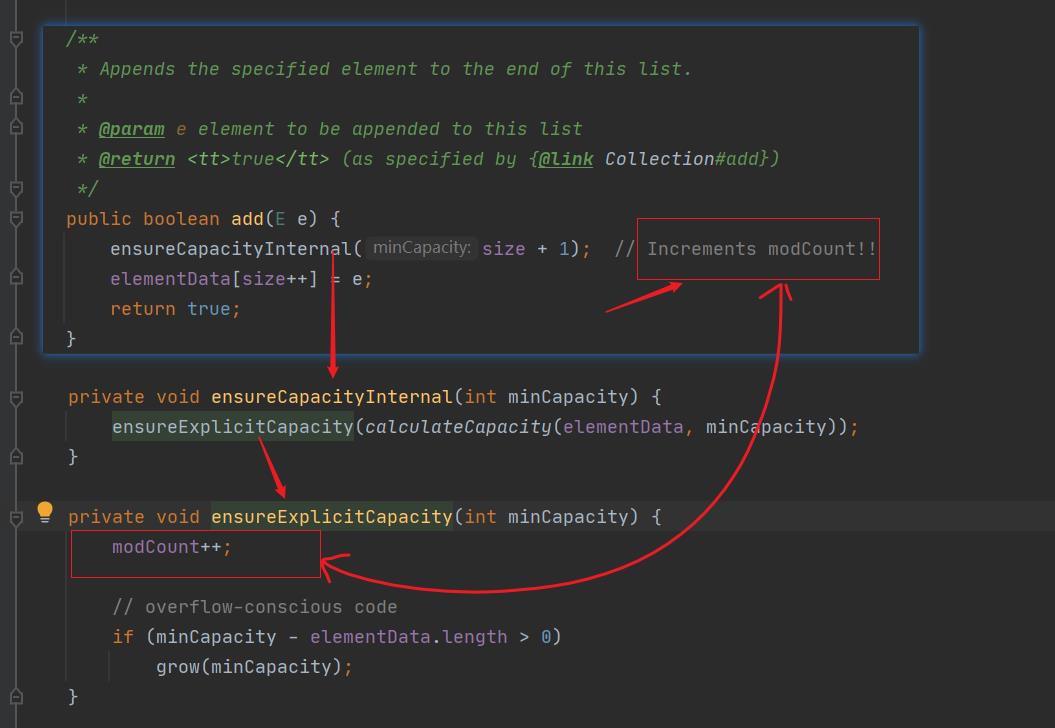
expectedModCount只会在迭代器的remove方法中被修改为modCount
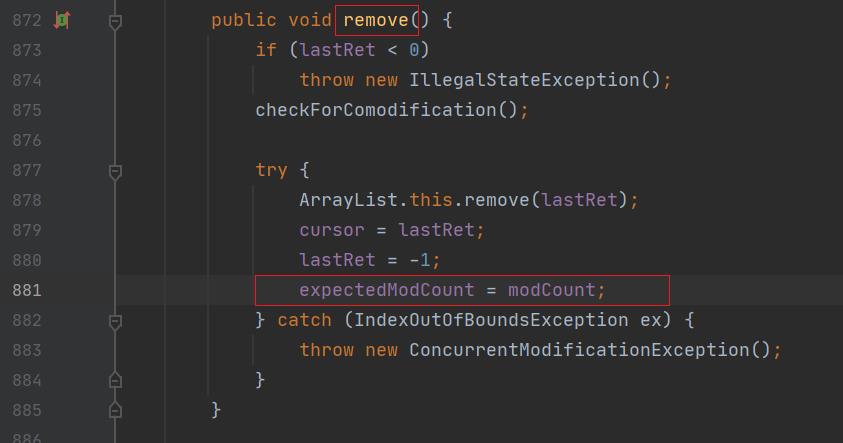
这都是  中的内容,除了modCount 。 modCount 是ArrayList的常量,默认值 为0
中的内容,除了modCount 。 modCount 是ArrayList的常量,默认值 为0 
为什么对集合的结构进行修改会发生并发修改异常-源码分析
那我们说,在用迭代器遍历一个集合对象时,如果遍历过程中对集合对象的结构进行了修改(增加、删除),则会抛出Concurrent Modification Exception 【并发修改异常】。
修改方法之 remove

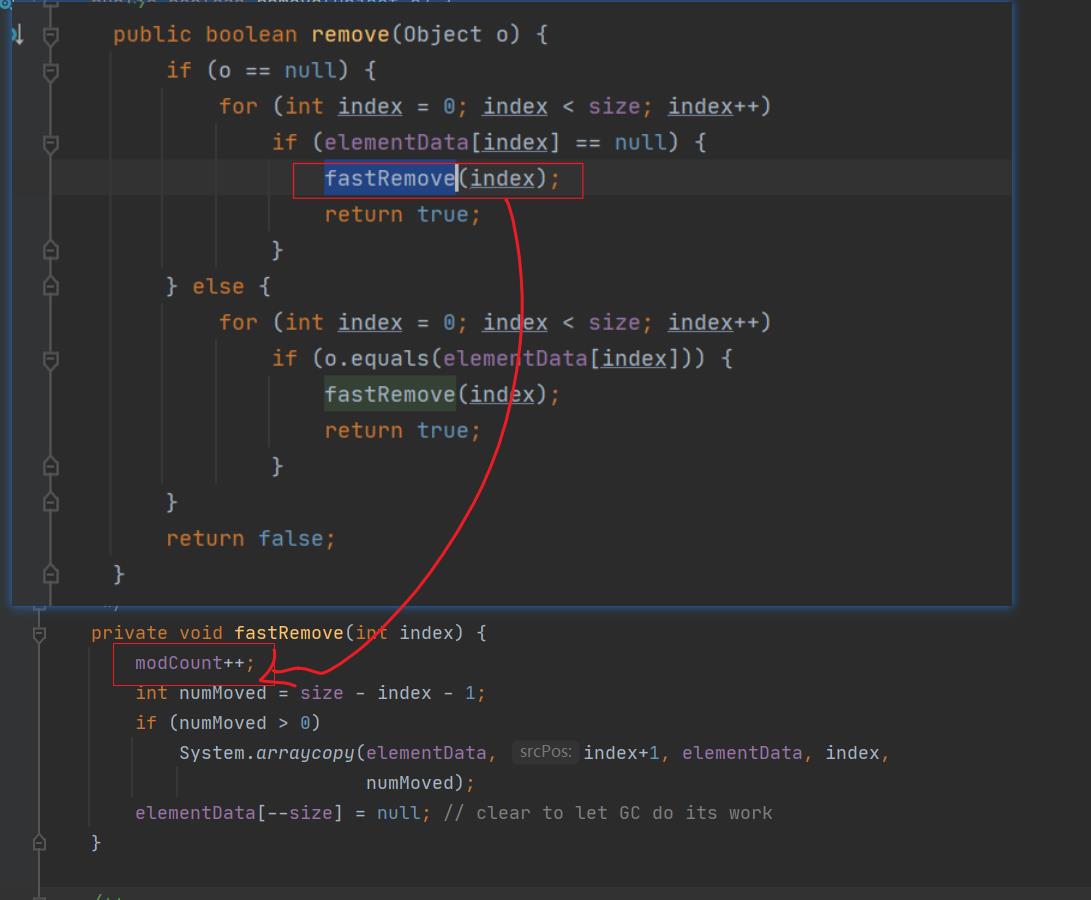
modCount++ , 后面modCount会和expectedModCount不相等,进而抛出并发修改异常。

修改方法之 add


ensureCapacityInternal方法里对modCount++操作, 改变了modCount的值,所以调用

那set方法会触发 fast fail吗?
答案是不会。

set没有对modCount++,所以对集合的某个元素进行修改并不会fail-fast
案例分享
【案例一】
List<String> list = new ArrayList<>();
list.add("1");
list.add("2");
list.add("3");
list.add("4");
Iterator<String> iter = list.iterator();
while (iter.hasNext()) {
String tmp = iter.next();
System.out.println(tmp);
if (tmp.equals("1")) {
list.remove("1");
}
}
1
Exception in thread "main" java.util.ConcurrentModificationException
at java.util.ArrayList$Itr.checkForComodification(ArrayList.java:911)
at java.util.ArrayList$Itr.next(ArrayList.java:861)
at com.artisan.fastfail.FastFailTest.main(FastFailTest.java:25)
调用了 list# remove方法
【案例二】
List<String> list = new ArrayList<>();
list.add("1");
list.add("2");
list.add("3");
list.add("4");
Iterator<String> iter = list.iterator();
while (iter.hasNext()) {
String tmp = iter.next();
System.out.println(tmp);
if (tmp.equals("3")) {
list.remove("3");
}
}
1
2
3
调用了 list# remove方法 , 居然没有抛出并发修改异常????

remove倒数第二个元素,然而这时就没有抛出异常了 。 再分析分析吧

cursor是下一个要返回的变量的下标
lastRet是上一个返回过的变量的下标

hasNext方法告诉我们只有在下一个变量的下标不等于size的时候会告诉我们集合还有下一个元素。
但是在remove的时候,size- -了,那么删除“3”这个元素后,size变为3,而此时cursor也是3,那么再走到hasNext时,就发现cursor和size相等了,那么就会退出遍历,“4”压根就不会被遍历到。
所以没有抛出异常,因为remove后就退出了,还没来得及走到next方法呢~
【案例三】
List<String> list = new ArrayList<>();
list.add("1");
list.add("2");
list.add("3");
list.add("4");
Iterator<String> iter = list.iterator();
while (iter.hasNext()) {
String tmp = iter.next();
System.out.println(tmp);
if (tmp.equals("4")) {
list.remove("4");
}
}
1
2
3
4
Exception in thread "main" java.util.ConcurrentModificationException
at java.util.ArrayList$Itr.checkForComodification(ArrayList.java:911)
at java.util.ArrayList$Itr.next(ArrayList.java:861)
at com.artisan.fastfail.FastFailTest.main(FastFailTest.java:25)
接上个案例
那 删除“4”,也就是最后一个元素,按理说删了最后一个元素不就退出了吗?走不到下一次的next方法呀?
其实是不对的,删完“4”并没有就直接退出 ! remove后size变成了3,但此时cursor是4,那么走到hasNext时,发现4!=3,就会再次进入循环,那么结果…走到了next方法,抛出了异常。。。
【案例四】
List<String> list = new ArrayList<>();
list.add("1");
list.add("2");
list.add("3");
list.add("4");
for (String i : list) {
if ("1".equals(i)) {
list.remove("1");
}
}
Exception in thread "main" java.util.ConcurrentModificationException
at java.util.ArrayList$Itr.checkForComodification(ArrayList.java:911)
at java.util.ArrayList$Itr.next(ArrayList.java:861)
at com.artisan.fastfail.FastFailTest.main(FastFailTest.java:22)
用增强for循环遍历的,反编译class , 和用迭代器实质是一样的 。
【案例五】
List<String> list = Arrays.asList("1", "2", "3", "4");
for (String i : list) {
if ("1".equals(i)) {
list.remove("1");
}
}
Exception in thread "main" java.lang.UnsupportedOperationException
at java.util.AbstractList.remove(AbstractList.java:161)
at java.util.AbstractList$Itr.remove(AbstractList.java:374)
at java.util.AbstractCollection.remove(AbstractCollection.java:293)
at com.artisan.fastfail.FastFailTest.main(FastFailTest.java:21)
用了Array.asList()方法生成的集合,抛出的是UnsupportedOperationException,发现asList生成的ArrayList是个静态内部类,并非java.util.ArrayList, 并没有这些方法。
所以不能对asList生成的ArrayList进行增删改
Java开发规范01 - 集合篇_Arrays.asList 坑
【案例六】
List<String> list = new ArrayList<>();
list.add("1");
list.add("2");
list.add("3");
list.add("4");
Iterator<String> iter = list.iterator();
while (iter.hasNext()) {
String tmp = iter.next();
System.out.println(tmp);
if (tmp.equals("1")) {
iter.remove();
}
}
1
2
3
4
【案例七】
```java
// Java code to illustrate
// Fail Fast Iterator in Java
import java.util.HashMap;
import java.util.Iterator;
import java.util.Map;
public class FailFastExample {
public static void main(String[] args)
{
Map<String, String> cityCode = new HashMap<String, String>();
cityCode.put("Delhi", "India");
cityCode.put("Moscow", "Russia");
cityCode.put("New York", "USA");
Iterator iterator = cityCode.keySet().iterator();
while (iterator.hasNext()) {
System.out.println(cityCode.get(iterator.next()));
// adding an element to Map
// exception will be thrown on next call
// of next() method.
cityCode.put("Istanbul", "Turkey");
}
}
}
India
Exception in thread "main" java.util.ConcurrentModificationException
at java.util.HashMap$HashIterator.nextNode(HashMap.java:1442)
at java.util.HashMap$KeyIterator.next(HashMap.java:1466)
at FailFastExample.main(FailFastExample.java:18)

// Java code to demonstrate remove
// case in Fail-fast iterators
import java.util.ArrayList;
import java.util.Iterator;
public class FailFastExample {
public static void main(String[] args)
{
ArrayList<Integer> al = new ArrayList<>();
al.add(1);
al.add(2);
al.add(3);
al.add(4);
al.add(5);
Iterator<Integer> itr = al.iterator();
while (itr.hasNext()) {
if (itr.next() == 2以上是关于Java - Java集合中的快速失败Fail Fast 机制的主要内容,如果未能解决你的问题,请参考以下文章